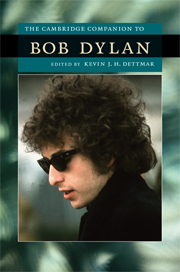Book contents
- Frontmatter
- Introduction
- Part I Perspectives
- 1 Bob Dylan and the Anglo-American tradition
- 2 Bob Dylan and Rolling Thunder
- 3 Bob Dylan as songwriter
- 4 Bob Dylan as performer
- 5 Bob Dylan and collaboration
- 6 Bob Dylan and gender politics
- 7 Bob Dylan and religion
- 8 Bob Dylan and the Academy
- 9 Bob Dylan as cultural icon
- Part II Landmark Albums
- Works cited
- Index
1 - Bob Dylan and the Anglo-American tradition
from Part I - Perspectives
Published online by Cambridge University Press: 28 May 2009
- Frontmatter
- Introduction
- Part I Perspectives
- 1 Bob Dylan and the Anglo-American tradition
- 2 Bob Dylan and Rolling Thunder
- 3 Bob Dylan as songwriter
- 4 Bob Dylan as performer
- 5 Bob Dylan and collaboration
- 6 Bob Dylan and gender politics
- 7 Bob Dylan and religion
- 8 Bob Dylan and the Academy
- 9 Bob Dylan as cultural icon
- Part II Landmark Albums
- Works cited
- Index
Summary
At the end of Todd Haynes's 2007 film I'm Not There, Cate Blanchett, one of the six actors playing a character inspired by Bob Dylan, sits in the back of a limo, smoking a cigarette, spouting fragments of dialogue directly transcribed from Dylan's 1966 Playboy interview with Nat Hentoff. Dylan was offering something new then - the rock concert - that would soon enough become as well worn as a Gerde's Folk City hootenanny soon enough. But the shock of the new was also entangled with archeological layers of vernacular tradition. Even in a rambling, opaque interview, Dylan - the character he played in Playboy who became the character played by Blanchett four decades later - manages to dodge and complicate his relationship to folk: a musical category he could never entirely ditch. When Dylan gives an interview, usually, nothing is revealed, yet Haynes's impressionistic riff on it - with nods to D. A. Pennebaker's 1965 Dylan tour documentary Don't Look Back and Fellini's 8½ - does reveal how the Dylan of our dreams remained tethered to something old, even when he was flying on amphetamines and snarling gnomic utterances over screeching feedback. Haynes cut and pasted through Dylan's interview patter, chock full of aphoristic non-sequiturs that already seemed fragmented: “jewels and binoculars hang from the head of the mule,” he sang, mixing and matching. When Dylan was faced with a question about the “folk tradition,” he neither accepted it as orthodoxy nor rejected it as defunct.
- Type
- Chapter
- Information
- The Cambridge Companion to Bob Dylan , pp. 15 - 27Publisher: Cambridge University PressPrint publication year: 2009
- 6
- Cited by



